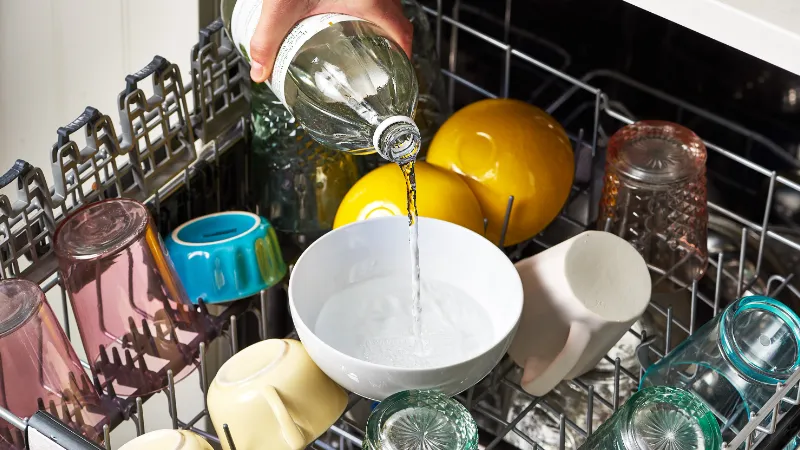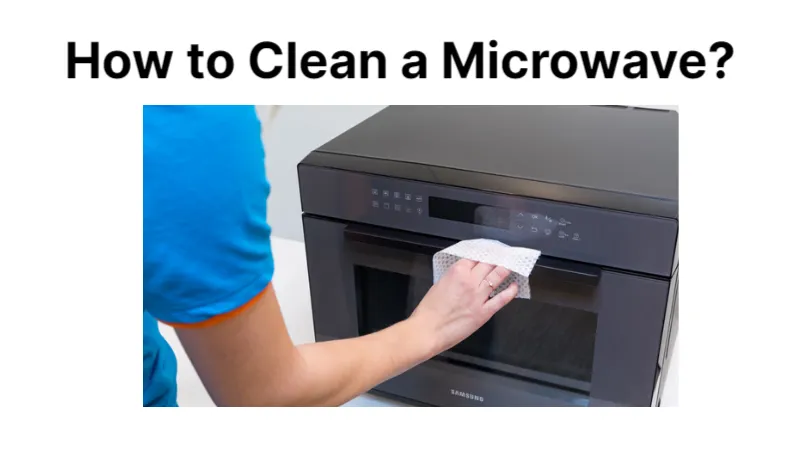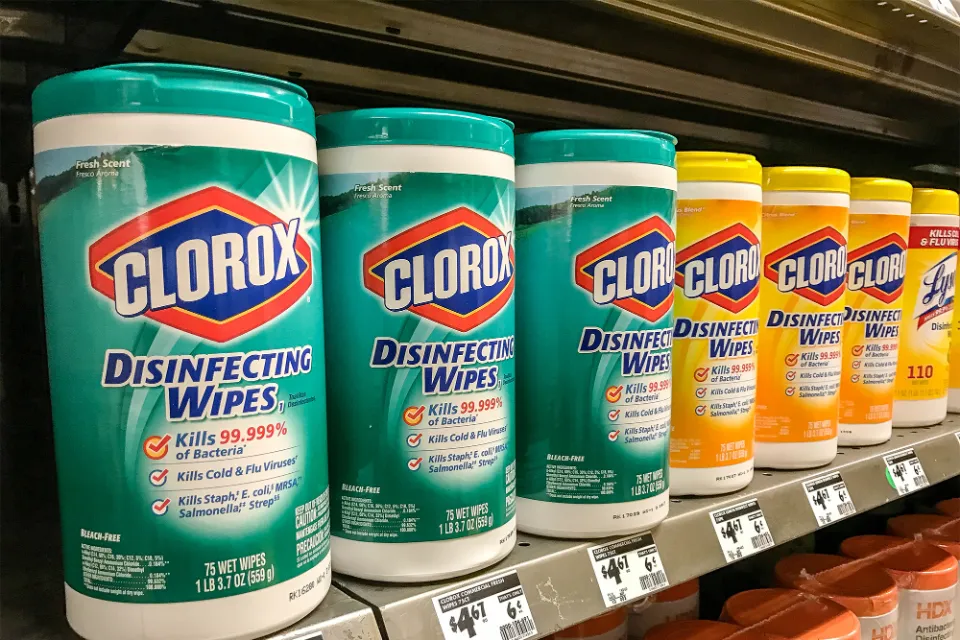Discover how to clean a dishwasher with vinegar safely. Your most-used appliance can be cleaned and sterilized using this easy trick involving vinegar.
Dishwasher should be emptied first, then one cup of white vinegar should be placed in a dishwasher-safe bowl and put on the top rack. Activate the dishwasher’s hottest cycle. Skip the drying cycle and leave the dishwasher door open to let the dishes air dry. During this cycle, be sure to omit the detergent.
Poole advises adding two cups of white vinegar and half a sink’s worth of warm water to your sink in order to clean removable dishwasher parts. The parts should be placed in the sink and left to soak for 20 minutes. After that, give them a rinse before repositioning them.
To learn more, keep reading.
How to Clean Your Dishwasher With Vinegar?
If you notice strong odors, food particles are redepositing on the dishes, or if the dishwasher isn’t draining well, a more thorough cleaning is required. Although you’ll need to add a few extra steps, the process begins exactly the same as the vinegar cleaning cycle.
Add Baking Soda to Help Control Odors
After the wash cycle is complete, open the door and sprinkle one cup of dry baking soda onto the floor of the dishwasher. Start a hot water rinse cycle only; skip the drying cycle. Open the door once the cycle is finished cleaning so you can finish while the interior is still damp. Nobody would be critical of you if you assumed that a dishwasher uses a sizable amount of water for each load. After all, one of the largest appliances in your home is usually this one. You may have wondered how much water does a dishwasher use.
Clean the Dishwasher Filter
Find the dishwasher filter and remove it. Pour some dishwashing liquid and hot water into a sink or a sizable bowl, and soak the filter for a few minutes to help the debris come loose. To remove any debris that has become lodged in the filter, use an old toothbrush or a soft-bristled nylon brush. Rinse well.
Replace the filter after cleaning the filter housing with a brush that has been dipped in vinegar.
Clean the Dishwasher Drain
The drain beneath the filter may have food particles stuck in it, which is why the area smells. Add 1/4 cup of baking soda to the drain after removing the filter. Then, add 1/2 cup of distilled vinegar to the drain opening. As the products react, foaming will occur. This reaction aids in loosening dirt so that it can be flushed out during a dishwasher cycle.
Reassemble the filter and any screens over the drain after allowing the mixture to work for 10 to 15 minutes, and then run a cleaning cycle.
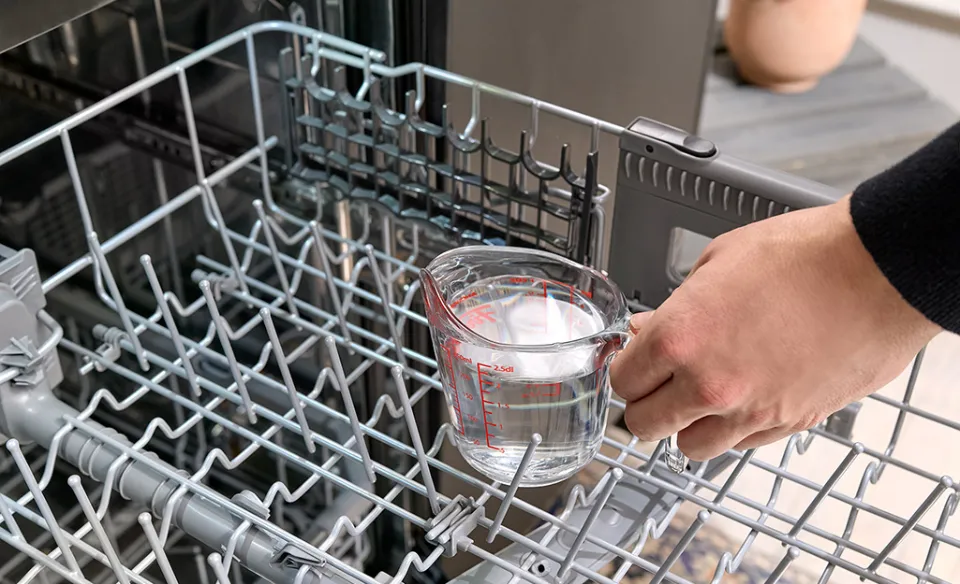
How Often to Clean a Dishwasher With Vinegar?
Put a reminder on your calendar to clean the interior of your dishwasher once a month with vinegar. By doing this, you’ll only need to perform a more thorough cleaning on your appliance once or twice a year.
‘How much does a dishwasher cost?‘ is a question you might wonder each time you load one up.
When to Use White Vinegar?
The acidity of vinegar is very high. This is why it works so well inside your dishwasher to dissolve tough deposits like grease. But there’s a reason that the vinegar is placed in an upright cup in this tutorial and not poured all over the surfaces:
- When exposed to highly acidic cleaners, rubber gaskets and seals can degrade over time. To remove any buildup, it is always best to use a soapy cloth on your rubber seals. Do not apply undiluted white vinegar to any rubber gaskets and seals.
- Only run white vinegar through your dishwasher if the dishwasher is empty. Dirty silverware or other metal containers that previously contained salt can be affected by a chemical reaction when in contact with vinegar.
Looking for a substitute for white vinegar? You can also sprinkle baking soda on the inside of your dishwasher and run it on a hot cycle. Additionally, baking soda can aid in cleaning and liquifying dishwasher buildup.
Suggested reading: How long do dishwashers last? This guide will tell you how to prolong the life of your dishwasher and keep it in good working condition.
Best Vinegar for Cleaning a Dishwasher
While there are dozens of types of vinegar, distilled white vinegar or cleaning vinegar are the best to use when cleaning. Tannins (plant dyes) that can stain some surfaces are absent from cleaning and distilled vinegar. Both are produced by distilling grains into alcohols, which are then left to ferment while microorganisms convert the alcohol to acetic acid, water, or vinegar.
For monthly cleaning, distilled white vinegar, which has 5% acetic acid and 95% water, is ideal. Cleaning vinegar contains around six percent acetic acid, making it 20% stronger than white distilled vinegar. If you’ve never cleaned your dishwasher or it has been a while, cleaning vinegar (which is more expensive) will cut through the build-up more easily.
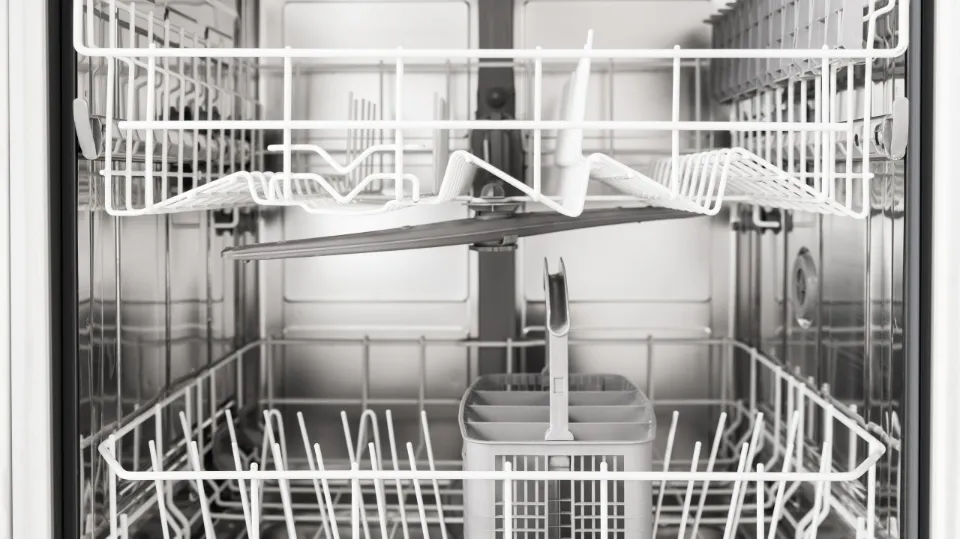
Other Tasks Between Dishwasher Deep Cleanings
Since the dishwasher’s drainage is frequently connected to the garbage disposal, always run the disposal before starting the dishwasher to keep it clean.
You can lessen buildup in the filter below the lower rack by pre-rinsing your dishes. After each wash, you should also look inside the dishwasher to see if there are any visible food remnants. In order to prevent them from rotting and creating unpleasant odors or clogged drainage, remove any that you find.
Remember to regularly wash the rubber gaskets in soapy water.
Tips to Keep Your Dishwasher Clean Longer
- Prior to running the dishwasher, remove any leftover food from the dishes.
- To remember to clean the dishwasher with vinegar each month, add a reminder to your calendar.
- In order for the water to easily circulate and flush away food particles, avoid overloading a dishwasher.
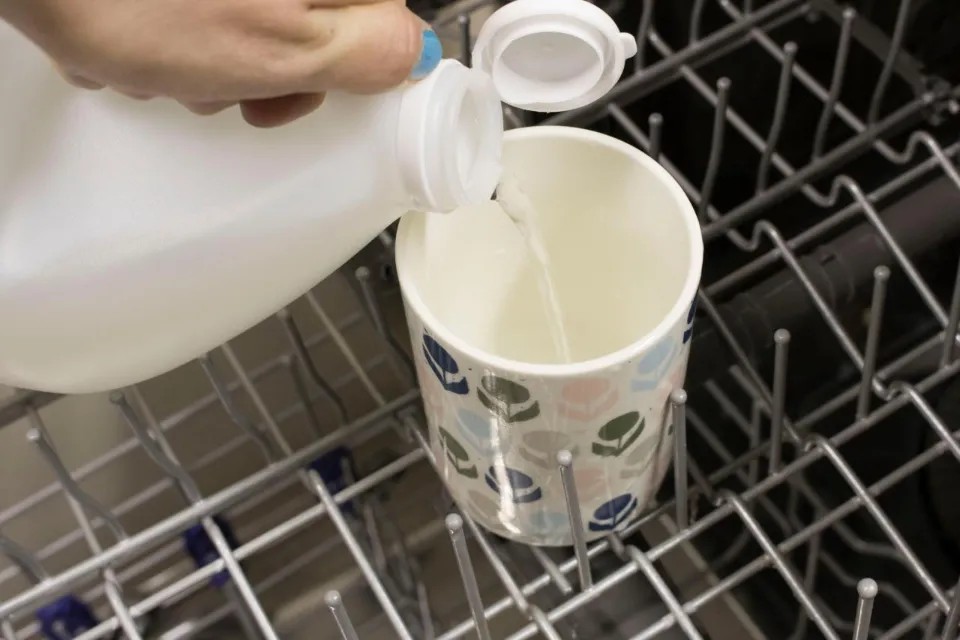
FAQs
Where Do You Put Vinegar in the Dishwasher?
To be on the safe side, put the vinegar in a dishwasher-safe bowl on the top rack of your dishwasher. (Additionally, this makes it easier for the vinegar to get to the dishes with the most pronounced hard water stains.)
Can You Put Vinegar in Dishwasher Dispenser?
First, you should not put vinegar in the rinse-aid dispenser in your dishwasher. The rubber gaskets in the rinse-aid dispenser can be melted by vinegar because it is an acid strong enough to do so. Bad. Some people advise running a rinse cycle while adding vinegar to a cup on the top rack.
Will Vinegar Damage a Dishwasher?
Vinegar could dry out the dishwasher’s rubber parts and cause them to crack and leak. You might end up with a kiddie pool for a kitchen in addition to this being an annoying and possibly expensive repair.
Can I Run Full Dishwasher With Vinegar?
To further sterilize, run the dishwasher on its regular cycle while using hot water. Vinegar is used to remove soap scum, food particles, and grease from the dishwasher’s walls and racks so that they can be flushed down the drain. Once the cycle is complete, open the door and remove the mug.
How to Clean a Dishwasher With Baking Soda?
- A full dishwasher bottom should be covered with 1 cup of baking soda.
- To let the dishwasher air dry, run a hot water cycle.
The interior of the machine is cleaned with baking soda, and any stains are removed. Do not use vinegar and baking soda in the same cycle. The two materials will start to foam, leaving you with a huge mess. Instead, a baking soda cycle should go first, then a vinegar cycle.
Summary: How to Clean a Dishwasher With Vinegar?
Vinegar is natural and safe to use in your dishwasher and works well as a DIY dishwasher cleaner. Empty the dishwasher first, then add one cup of white vinegar to a dishwasher-safe bowl and set it on the top rack. Start the dishwasher’s hot cycle. Leave the dishwasher door open and skip the drying cycle to let the dishes air dry. Make sure to skip the detergent during this cycle.
To clean removable dishwasher parts with vinegar, Poole suggests filling your sink half-full of warm water and adding two cups of white vinegar. Put the components in the sink and soak them for 20 minutes. After rinsing them, replace them where they were.
If you have any questions, please leave a comment. My Prime Home tries to give you the best home improvement information. Don’t forget to share the post. Thank you for reading.
You may also interested:
